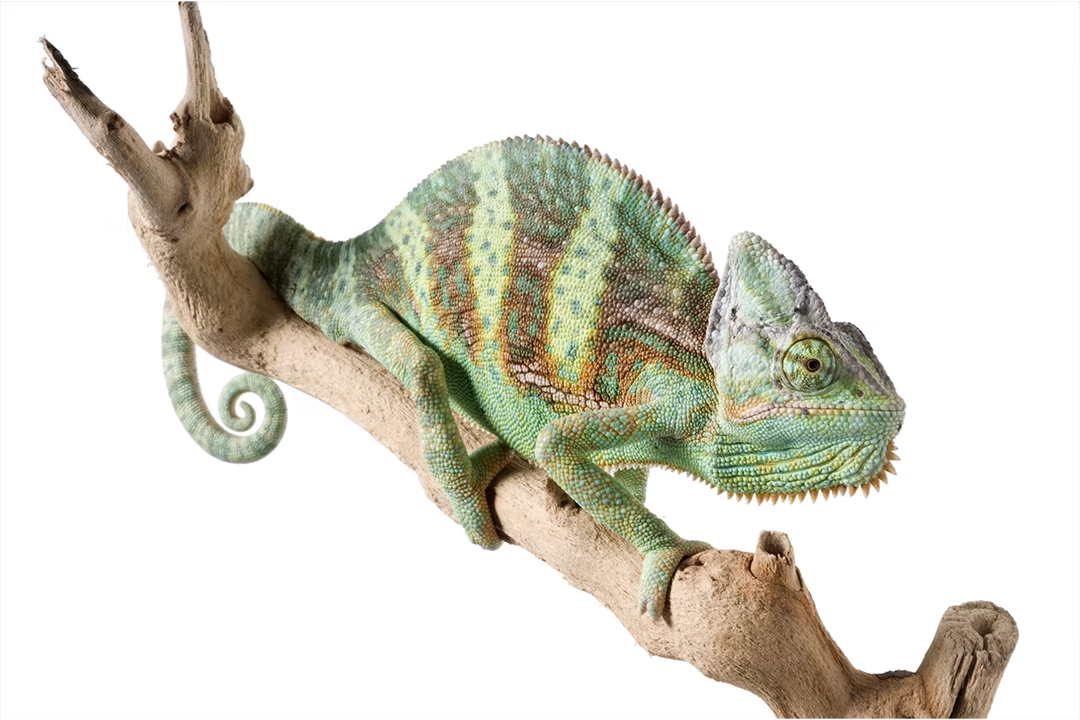The best cage for a veiled chameleon is a tall, screened enclosure that provides ample climbing space and ventilation. ReptiBreeze by Zoo Med is a popular choice among chameleon owners.
Veiled chameleons require a habitat that mirrors their natural environment to thrive, and choosing the right cage is essential. A vertical space allows these arboreal reptiles to climb and bask as they would in the wild. Screened cages are preferable because they ensure proper airflow, reducing the risk of respiratory issues.
The enclosure should be equipped with branches, plants, and appropriate lighting to simulate the chameleon’s natural habitat. A sizeable, well-ventilated cage supports not only the physical well-being of your veiled chameleon but also its mental health by providing a space for exercise and exploration. Selecting a cage like the ReptiBreeze makes setup and ongoing care easier, helping your chameleon to lead a healthy, happy life.

Credit: www.petco.com
The Veiled Chameleon: A Brief Introduction
Selecting the ideal enclosure ensures your veiled chameleon thrives in captivity. Glass terrariums with ample vertical space cater to their arboreal lifestyle and facilitate temperature regulation, essential for their well-being.
Vibrant colors and impressive camouflage skills set the veiled chameleon apart. This reptile’s distinct crest, or “veil”, on its head makes it a favorite among reptile enthusiasts. Originally from the Arabian Peninsula, the veiled chameleon brings a slice of exotic wildlife into your home.
Unique Traits Of Veiled Chameleons
- Color Changing: They change colors based on mood, health, and temperature.
- Casque: The helmet-like ridge on their head is called a “casque”.
- Tongue: They catch prey with long, sticky tongues, often longer than their own body.
- Eyes: Their eyes move independently to watch two directions at once.
Natural Habitat Considerations
Replicating their natural environment is essential for a veiled chameleon’s health. They thrive in warm, humid conditions with plenty of vertical space and foliage for climbing.
| Feature | Requirement |
|---|---|
| Temperature | 72-80°F (day), 60-70°F (night) |
| Humidity | 50-70% |
| Lighting | UVB for 12 hours a day |
| Vegetation | Non-toxic plants for coverage |
Importance Of Choosing The Right Cage
Selecting the perfect cage for a veiled chameleon is crucial. It affects their health and happiness. A proper cage encourages natural behavior. This leads to a thriving life for your pet.
Health And Wellness
Health and wellness start with the right habitat. Chameleons need space to climb and proper ventilation to prevent respiratory issues. The right cage supports these needs. It also helps manage temperature and humidity essential for their wellness.
- Vertical space for climbing
- Mesh walls to promote airflow
- Stable temperatures and humidity, mimicked from their natural habitat
Mimicking The Wild: Why It Matters
Veiled chameleons are from Yemen and Saudi Arabia. Their cages should resemble these environments. Providing a mini-habitat that mimics the wild contributes to psychological health. This encourages natural behaviors like hunting and exploring.
| Feature | Importance |
|---|---|
| Plants and Branches | Encourages natural movement |
| UVB Lighting | Mimics sunlight for vitamin D synthesis |
| Drip System | Simulates rain for drinking water |
Cage Size And Dimensions
Choosing the right cage size and dimensions for your veiled chameleon is crucial. A suitable habitat ensures they thrive and display natural behaviors. Let’s dive into what your colorful friend needs in terms of living quarters.
Minimum Requirements
A veiled chameleon needs more than just a place to rest. For a single adult, you’ll need a cage that’s at least 36 inches tall, 24 inches wide, and 24 inches deep. Youngsters can start in smaller spaces but grow quickly.
| Age | Height | Width | Depth |
|---|---|---|---|
| Young | 16″ | 16″ | 30″ |
| Adult | 36″+ | 24″+ | 24″+ |
Room To Climb: Vertical Space Importance
Veiled chameleons relish climbing. Vertical space is key for their health and happiness. Tall enclosures give them the freedom to move upwards, mimicking their natural inclination in the wild to head for the trees.
- Include branches and vines for climbing.
- Opt for tall plants that provide shelter.
- Ensure there’s space for thermal regulation; they need to move between warmer and cooler areas.
Material Matters: Selecting Cage Construction
Choosing the right home for your veiled chameleon is crucial. Material plays a significant role in their health and happiness. Let’s explore the various cage materials and their implications.
Pros And Cons Of Glass Terrariums
Glass terrariums offer a view into your chameleon’s world. They retain humidity well, which is good for hydration. Yet, glass can be heavy and may not provide enough ventilation. This can lead to respiratory issues for your pet. Here’s a quick breakdown:
| Pros | Cons |
|---|---|
|
|
Benefits Of Screen Cages
Screen cages are another popular choice. These cages allow for excellent air circulation. Adequate airflow helps prevent respiratory infections. Screen cages also make it easy to maintain a temperature gradient. Your chameleon will love this. Here are the key benefits:
- Great ventilation
- Lightweight and portable
- Allows natural temperature shifts
Optimal Cage Setup
The key to a healthy, happy veiled chameleon is an optimal cage setup. Your pet requires a habitat that mimics their natural environment. This includes the right temperature, humidity, and ample space. Achieve this, and watch your chameleon explore and thrive.
Creating A Microclimate
Veiled chameleons need a specific environment to survive. A microclimate is essential. It offers the right heat and moisture. This type of climate supports their natural behavior and health.
- Temperature: Aim for a gradient of 72-80°F (22-27°C) during the day and cooler at night.
- Humidity: Keep it between 50%-70%.
- Ventilation is vital. It prevents respiratory issues.
Use thermometers to monitor the temperature. Hygrometers help check the humidity level. Digital options ensure accuracy.
Essential Cage Accessories And Decor
Accessories turn a cage from a container into a home. Here’s what to include:
| Accessory | Purpose |
|---|---|
| UVB Lighting | Simulates sunlight, aids in vitamin D production |
| Basking Lamp | Provides warmth, helps regulate body temperature |
| Plants | Offers hiding spots, increases humidity |
| Branches | Supports climbing, encourages natural behavior |
| Water Drip System | Encourages drinking, maintains humidity |
Decor items like non-toxic plants and branches are essential. They add beauty and function. Remember to secure all decor tightly.
A water drip system mimics rainfall. Chameleons drink by licking water drops from surfaces. Consider a shallow dish on the cage floor too.
Remember, the right cage accessories create a stimulating and secure environment. They are crucial for your chameleon’s well-being.

Credit: chameleonacademy.com
Lighting And Temperature Control
Choosing the right cage for your veiled chameleon is crucial.
It’s not just about the space; lighting and temperature control are key to their health.
A veiled chameleon needs a home that mimics their natural habitat.
Let’s explore the essentials of UVB lighting and thermal gradients.
Uvb Lighting Essentials
Veiled chameleons thrive under UVB light, which is vital for their overall well-being.
UVB lighting helps them produce vitamin D3.
This vitamin allows chameleons to absorb calcium from their diet.
Without UVB, veiled chameleons can develop health issues like Metabolic Bone Disease.
- Install a UVB bulb in your chameleon’s cage.
- Ensure the bulb stretches across half of the cage.
- Replace the UVB bulb every 6 months.
- Keep the light on for 10-12 hours a day.
Thermal Gradients For Health
Just like in their natural habitat, temperature variation inside the cage is essential.
Veiled chameleons need warm basking zones and cooler areas to regulate their body temperature.
| Basking Area Temperature | Cool Zone Temperature |
|---|---|
| 80-85°F (27-29°C) | 72-80°F (22-27°C) |
Create a temperature gradient in the cage from top (warm) to bottom (cool).
A digital thermometer can help monitor temperatures.
Use a ceramic heat emitter or basking lamp for the warm zone.
Placing the heat source at one end creates the gradient naturally.
Humidity Requirements
Humidity requirements are crucial for your veiled chameleon’s health. These exotic reptiles thrive in environments that mimic their natural habitat. Creating the perfect home involves maintaining the correct levels of humidity. This not only supports their respiratory health but also aids in shedding and hydration. Let’s dive into the ways you can achieve this balance.
Maintaining Proper Humidity Levels
Ensuring the right humidity levels can be a game-changer. A veiled chameleon needs a humidity range between 50%-70%. To monitor this, an accurate hygrometer is essential. You can place this device inside the cage. It will help you keep an eye on the humidity. Remember, correct levels prevent stress and common health issues.
Misting Systems Vs. Manual Methods
Misting systems automate the process of creating a humid environment. They can be set to mist the cage at regular intervals. This is both convenient and consistent.
- Pros:
- Regular hydration
- Less hands-on time
- Adjustable mist levels
- Cons:
- Higher initial cost
- Potential for mechanical failure
On the other hand, manual methods include hand spraying or using a drip system. These require more effort but offer direct control.
- Pros:
- Immediate humidity control
- Affordable to implement
- Customizable to needs
- Cons:
- Time-consuming
- Less consistent than systems
Ease Of Maintenance
Keeping a veiled chameleon as a pet requires a clean, safe habitat. Choosing a cage that’s easy to maintain helps your vibrant friend stay healthy. Focusing on ease of maintenance not only benefits your chameleon but also simplifies your daily routine.
Cleaning Best Practices
To ensure your veiled chameleon’s home is sparkling clean, follow these tips:
- Remove uneaten food daily to prevent rot and pests.
- Wipe down surfaces weekly using reptile-safe disinfectants.
- Deep clean monthly; this includes substrate changes and decor washes.
Regular cleaning keeps the environment fresh and odor-free and mimics their natural habitat.
Accessibility For Daily Care
Easy access to your pet’s cage is vital for day-to-day care. Here’s what to look for:
| Feature | Benefit |
|---|---|
| Front-opening doors | Facilitates effortless feeding and cleaning. |
| Removable trays | Makes disposing of waste simpler. |
| Large access ports | Allows for easy installation of lighting and misting. |
Choosing a cage with these features means hassle-free maintenance. Your veiled chameleon will thrive in a habitat that’s as easy for you to care for as it is comfortable for them.
Top Cage Picks For Veiled Chameleons
Choosing the perfect cage for a veiled chameleon is crucial. These unique reptiles need space to climb, explore, and regulate their temperature. Let’s dive into our favorite picks. They include robust features and appropriate dimensions. They ensure your veiled chameleon thrives in a safe environment.
Expert And Hobbyist Recommendations
Experts and experienced hobbyists know what makes a great veiled chameleon habitat. They recommend cages based on ventilation, size, and ease of cleaning. Their insights help us identify top enclosures.
- ReptiBreeze Open Air Cage: Preferred for superior airflow.
- Zoo Med ReptiBreeze IguanArium: Spaces out for optimal heat gradient control.
- DIY Screen Cages: Customizable to specific needs.
Product Reviews And Comparisons
Reviews and comparisons guide us through countless options. Each product offers different benefits. We align them with a veiled chameleon’s needs. Below is a table with our top cage picks and how they stack up.
| Cage | Material | Size | Features |
|---|---|---|---|
| ReptiBreeze Open Air Cage | Aluminum | 24″x24″x48″ | Excellent airflow, easy to assemble |
| Zoo Med ReptiBreeze IguanArium | Mesh | 36″x18″x48″ | Large doors, PVC bottom for easy cleaning |
| DIY Screen Cages | Varied | Custom | Perfect fit for specific needs, allows creativity |
Diy Cage Options
Common Mistakes To Avoid
Choosing the perfect cage for a veiled chameleon is crucial. Their health and happiness depend on it. Yet, many owners make mistakes. Let’s ensure you’re not one of them.
Overlooking Ventilation
Good airflow keeps a chameleon healthy. A cage with poor ventilation can lead to respiratory problems. These enclosures should have a mix of glass and mesh. The blend fosters ample airflow. The right balance prevents stagnant air, a common cause of illness.
- Mesh tops or sides allow good air exchange.
- One side glass, others mesh, could work well.
- Too much mesh and your pet might get too cold.
Inadequate Lighting And Heating
Veiled chameleons need UV light and warmth to thrive. Their homeland offers plenty, but a home cage might not. A common oversight is not providing the right bulbs or heating elements.
| Feature | Requirement |
|---|---|
| UV Light | It helps in vitamin D production. |
| Basking Spot | Should be warmer, around 85-95°F. |
| Ambient Temperature | Should be lower, around 72-80°F. |
Proper set-up ensures your chameleon can regulate its body temperature. It also helps in preventing metabolic bone disease.
- Install a good UVB bulb for the light cycle.
- Provide a basking light for heat.
- Use a reliable thermometer to check temperatures.

Credit: chameleonacademy.com
Wrapping Up: Ensuring Chameleon Happiness
Welcome to the final segment on finding the perfect cage for your veiled chameleon. A chameleon’s happiness hinges on its habitat. It’s crucial to replicate their natural environment to keep these spectacular reptiles healthy and content. This part of the guide puts a bow on our comprehensive discussion by focusing on the best practices for habitat success and ongoing care education.
Final Tips For Habitat Success
To cement chameleon well-being, let’s explore some conclusive advice:
- Select the right size: A tall and spacious cage is vital.
- Ventilation is key: Ensure the cage has ample airflow.
- Light it right: UVB lighting supports healthy bone growth.
- Safe plants: Non-toxic plants offer hiding spots and moisture.
- Clean frequently: A hygienic habitat prevents disease.
Consistency with temperature and humidity mimics their natural habitat. A thermal gradient allows chameleons to self-regulate their body temperature. Making these elements a priority is a step towards happiness for your colorful friend.
Continued Learning For Chameleon Care
Keeping your veiled chameleon thriving involves continuous learning. The following resources are a goldmine of information:
- Reptile-focused websites
- Books by herpetology experts
- Online forums for chameleon enthusiasts
- Local herpetological societies
Invest time in understanding your pet’s behaviors and needs. This will reinforce the bond you share. Always seek advice from seasoned chameleon keepers and veterinarians. Your dedication to education is a measure of your commitment to your chameleon’s happiness.
Frequently Asked Questions
What Size Cage Does A Veiled Chameleon Need?
Veiled chameleons require spacious cages for adequate movement. An ideal cage size is at least 2 feet wide, 2 feet long, and 4 feet tall. Such dimensions provide sufficient space for climbing and exercise, which is vital for their well-being.
How To Choose The Best Chameleon Cage Material?
When choosing a cage for a veiled chameleon, opt for materials that allow good ventilation. Screened cages made of aluminum or steel mesh are most suitable as they offer excellent airflow and prevent respiratory issues in chameleons.
Are Vertical Or Horizontal Cages Better For Chameleons?
Chameleons benefit from vertical space due to their climbing nature. A taller, vertical cage mimics their natural arboreal habitat. Ensuring a cage has sufficient height allows for a more comfortable and stimulating environment for a veiled chameleon.
Can I Keep My Veiled Chameleon In A Glass Terrarium?
Glass terrariums are not ideal for veiled chameleons as they can have limited ventilation. Chameleons require a mesh or screened enclosure that promotes air circulation. This helps in reducing the risk of respiratory infections and regulating the humidity inside the habitat.
Conclusion
Selecting the right habitat for your veiled chameleon is vital for their well-being. The perfect cage combines size, ventilation, and material quality to ensure a thriving environment. Invest wisely in a suitable enclosure and watch your colorful companion flourish in a space tailored to its unique needs.
Happy chameleon parenting!



